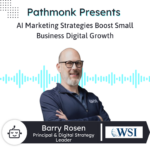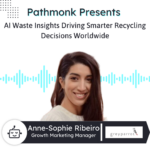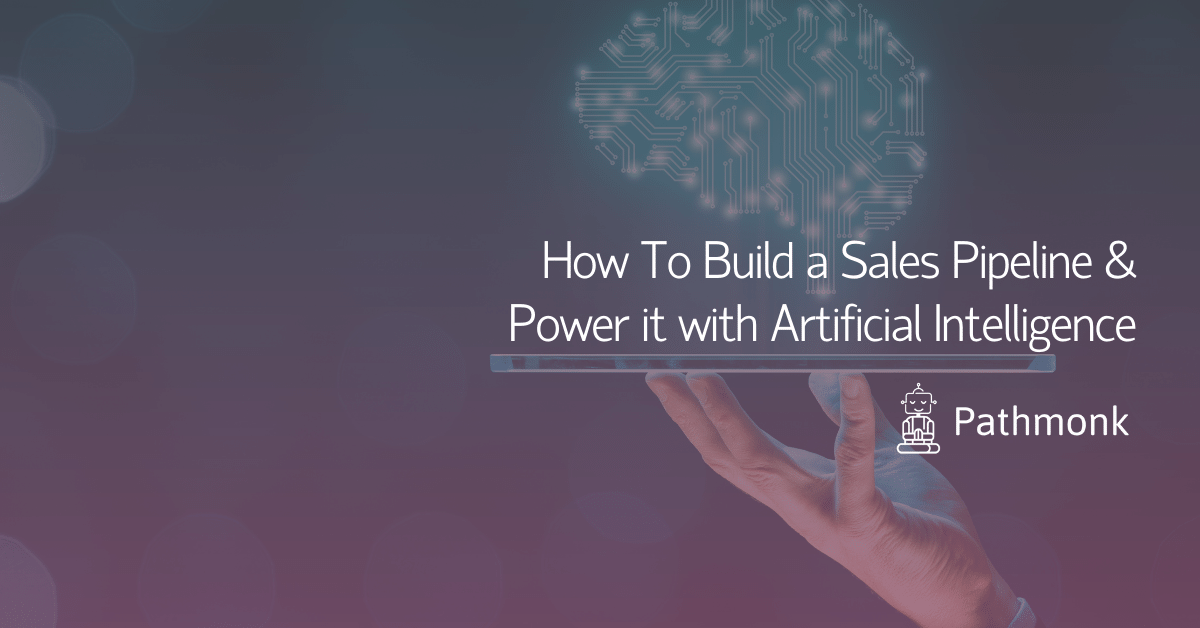
The Sales Pipeline: The Heart of Your Business
If you are a newborn startup or a solid successful business, you have all something in common, your sales funnel is the heart of your business.
What is a sales pipeline? It is a structured set of steps that tracks the stages of the buying process.
So in this article, we are going to review how to build a sales pipeline and make the heart of your business, push more revenue, identify possible improvements, detect the bottlenecks, etc.
The Foundation of all Sales Funnels: Measure
Before going into the building process, let’s set the foundation. We should be very methodical when working with sales funnels to obtain solid results. Our preferred strategy is always to have a complete understanding of the different stages and that is why we can not emphasize enough the importance of measuring and collecting data.
“If you can not measure it you can not improve it”.
This quote from Kelvin (yes, the same as the unit of temperature) reflects exactly the concept if you can not measure, or in most cases, you are not measuring, it is simple, you can not improve it.
So first thing first, you can start with something simple, getting a spreadsheet document, and start tracking all the different values, here is an example for reference:
|
Event |
Value |
Conversion |
|
Web visitors |
1000 |
— |
|
Visitors that booked a demo |
10 |
1% |
|
Deal closed |
2 |
20% |
To calculate each step conversion percentage we use the following formula:
Current step value / Previous step value * 100
Example for the deal closed: 2 / 10 = 20%
(To know more about conversions and check this free tool Pathmonk metrics)
Generate better leads to grow your sales
Discover new strategies to unlocking a flood of high-quality leads from your website.
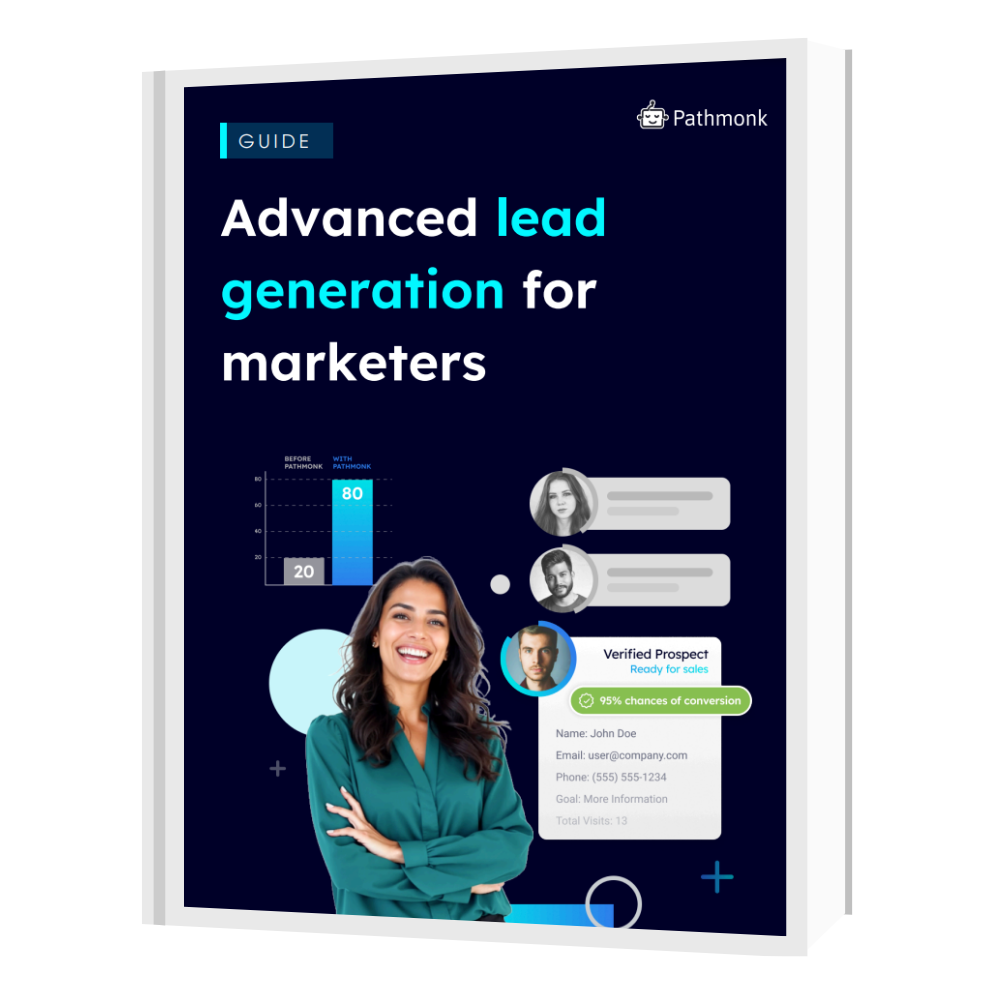
Building a Sales Pipeline
Now that we have talked about why the sales funnels are important and why we need to measure everything we can jump into the actual building process, let’s get into it.
The next picture represents a generic sales funnel concept, every company is different and has unique cases, also a company can have 1 or more sales pipelines.
For example, one for your mid-tier clients using inbound strategies and a second one for enterprise tier clients using outbound strategies.
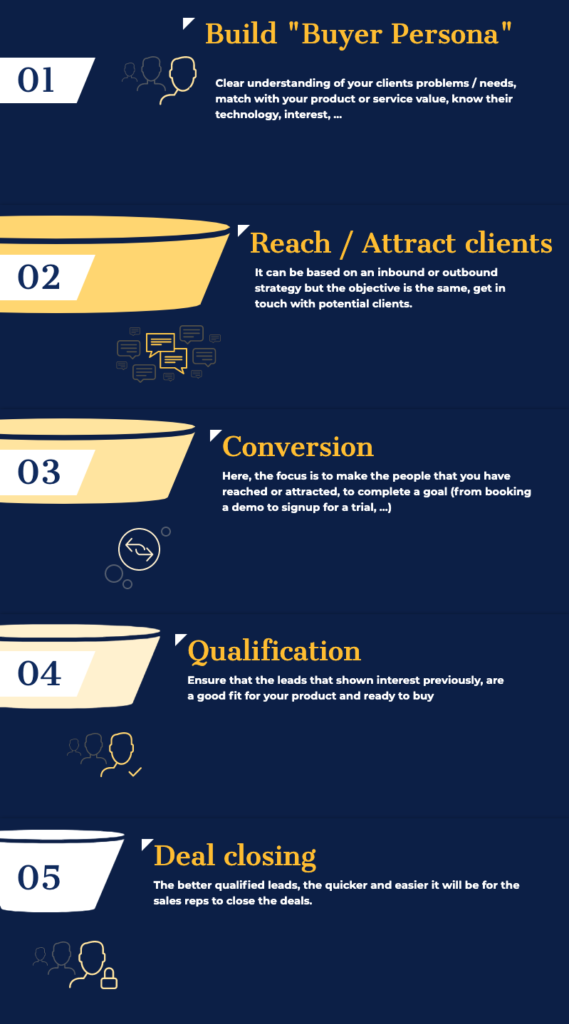
First Step: Know who To Sell To.
For that, we create our Ideal customer profile/buyer persona. There is plenty of documentation around for this.
With the Buyer Persona finished we have a clear understanding of their problems/needs, how that matches with your product or services, and their common patterns (the type of info they read, the events they attend, etc)
Second Step: Reach and Attract Target Clients.
This step will vary based on your strategy (outbound, inbound, etc). But the concept is the same, get in touch with potential clients by either reaching them directly or bringing them to your webpage or conversion channel.
For example, An inbound sales plan where you use SEO to bring traffic to your website based on specific keywords “invoice generation”.
Here is where we start the measuring steps, this will be the start of the funnel and goes from advertisement to visitors, to successful sign-ups/demos booked or whatever your end goal is.
Third Step: Convert Visitors into Leads, Prospects, Potential Customers…
If you hit the pain points or needs of your clients, they will want to try your product and service or will contact you to know more about how you can help them.
This step has a high impact on your sales funnel, a low conversion rate here will make all of your previous efforts go to waste.
Remember also that is not just about how many people you attract, but also their “buying intention” and their actual match with the value proposition of your product and service.
Fourth Step: Lead (or prospect) Qualification
If your product or services require to connect with your leads (contrary to an eCommerce for example where clients can directly buy the articles), then we have to ensure that the time that our sales teams spend with the leads is put in good use and not with clients that are not a fit or they are not ready to buy.
This process is one of the most challenging when companies start getting a certain volume because you want to filter and prioritize the good leads, also you want to be prepared for the selling meeting and ready to know as much as possible from your leads.
In this step, we always look into three key factors that drive success.
- Buyer: the more you know and the client the better, the estimated deal value, buying intention, the product they are interested in, etc.
- Speed: You want to connect with the most relevant leads first since the longer they wait the more likely you miss the deal.
- Routing: Usually the sales process requires putting each lead into the right bucket (enterprise, mid-tier, etc) also to assigning to the right person (the specialist in a specific product ) and providing the right action in each case: booking a meeting with a sales representative, provide a trial, etc
Fifth and Final Step: Closing the Deal.
This goes from demoing the product, convincing the lead, negotiation, etc. The better the experience in the previous process and the better the qualification of the leads the easier the selling will be.
Congrats now we have a funnel. And now, we need to rebuild the funnel again…
Wait what???
Yes and no. This is an ongoing process, it won’t get as extreme as rebuilding the funnel from zero but it is required to keep improving, detecting issues (like bottlenecks, …) as the market changes or your business growths, and for that the measuring that we mentioned initially will be essential.
Here is an example of a sales funnel that you can use as an inspiration for building yours.
Example for a company with an inbound strategy based on the advertisement that required qualification:
|
Event |
Value |
Conversion |
|
Ads campaign impressions |
30000 |
— |
|
Web visitors |
3000 |
10% |
|
Visitors that booked a demo |
60 |
2% |
|
Leads that qualifies |
36 |
60% |
|
Deal closed |
9 |
25% |
The next one is the cherry on the cake, to help plan your sales target, we are going to do a quick sales performance prediction; we need to add one more piece of information to the measuring funnel we had before.
Acquisition cost or Cost Per Acquisition (CPA)
And here is a simplified example following the previous line.
|
Acquisition action |
Cost |
|
Ads campaign / demos booked |
40€ |
|
Sales qualification cost |
20€ |
|
Sales cost |
120€ |
| Total |
180€ |
That will give a rough acquisition cost of 180€ per client, this is very useful also for your business plan (in combination with the lifetime value of a client).
Artificial-Intelligence-Powered Sales Pipeline
As you already saw and probably you have experienced in your business, there are especially 2 big challenges when building sales funnels, especially for the ones that require bringing traffic to your website and also require qualification.
The first and more painful is the qualification, as mentioned before we look at three metrics:
- Buyer: the more you know about the lead the better, estimated deal value, buying intention, the product they are interested in, etc.
- Speed: You want to connect with the most relevant leads first since the longer they wait the more likely you miss the deal.
- Routing: Usually the sales process requires putting each lead into the right bucket (enterprise, mid-tier, etc.) also to assigning to the right person (the specialist in a specific product) and providing the right action in each case: a booking with a sales representative, provide a trial, etc.
The old way solutions will involve manual verification, namely the role of an SDR to qualify and assign the leads affecting heavily the speed and experience. Also, there is some data that only can be obtained directly from the leads, so a qualification meeting or mail exchange is required affecting the overall process.
Here at Pathmonk, we have built an AI-powered solution to specifically solve that problem by automating the whole process, instantly qualifying the leads, estimations of key information like the deal value or the buying intention, and routing them to the right person and sales steps in your funnel.
If you want to know more about lead qualification click here.
The second is the direct conversion from your web visitors. This usually falls on the shoulders of the marketing team but it adds massive improvements to the whole performance of the sales funnel. Especially when combined with qualification too.
Usually, in order to try conversion optimization on your website, it is required to adapt the message, do A/B testing, heat maps, optimize CTA, etc.
And that is the main purpose of one of our tools, within Pathmonk the solution will escort your visitor from the very first visit to increase conversion, all of that automated and powered with Artificial Intelligence.
If you want to know more about conversions check this.
With this guideline, we hope you could find some help on how to build a solid sales pipeline, remember that it will take some iterations until you finally get a healthy and solid sales process that can generate a consistent and predictable revenue stream.
Understand your customer journey analytics
See how your users behave, find drop-offs, and receive actionable insights with AI.


